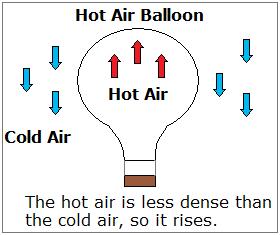Hot air rises. Heated air molecules “spread out” or expand and bounce around, and the space becomes less dense than the surrounding space. Increasing the air temperature inside the balloon envelope makes it less dense than the air, thus making it “lighter than air”. The amount of lift depends on the difference between the temperature inside and outside of the envelope, and the weight that is being lifted. Cooler seasons allow for less propane usage and provide lift at lower internal temperatures. Hotter seasons use more propane and can increase wear on the material from higher temperatures needed to achieve lift. Hot Air Balloon envelopes can withstand temperatures up to approximately 250°F for long periods of time.

Hot air balloon burners use liquid propane tanks (just like your grill) that travel through tubes to the burner to heat the envelope of the balloon. Some burners have an auto-spark feature, and the pilot also carries a lighter or flint to relight as needed. As the flame burns, it heats up the metal tubing and turns the liquid propane into gas. The gas is more powerful and efficient in this form and will quickly heat the balloon. As the envelope cools, the pilot can add more heat to rise, or let it cool (or vent it) to descend. Since hot air rises, the hot air will stay in the envelope and will keep the envelope expanded.





